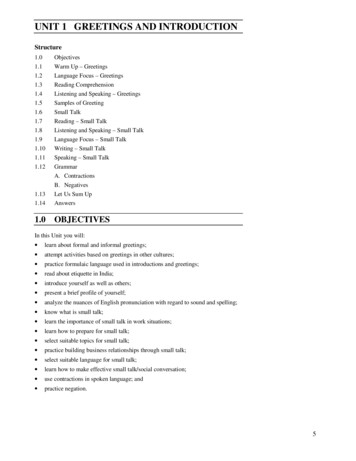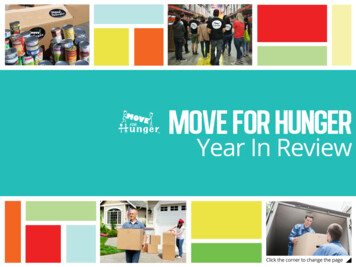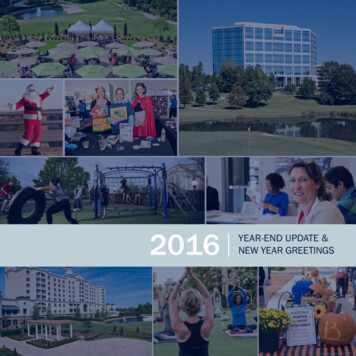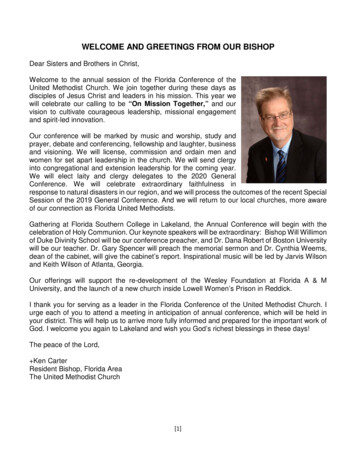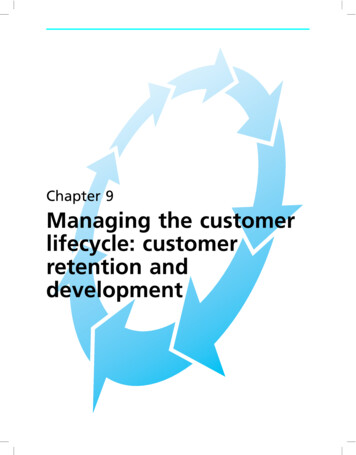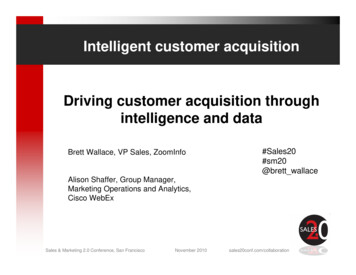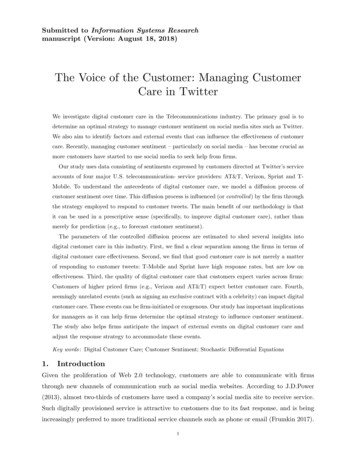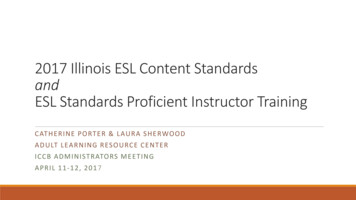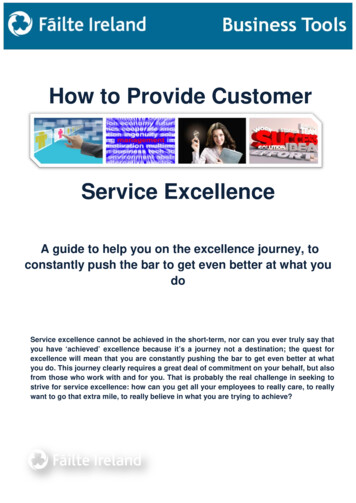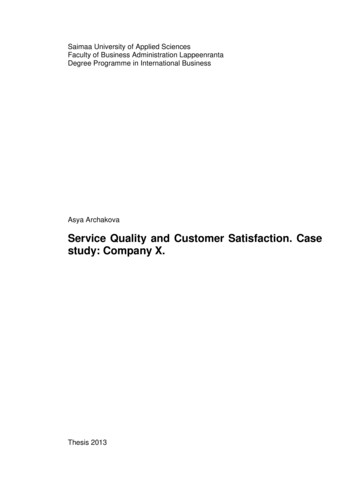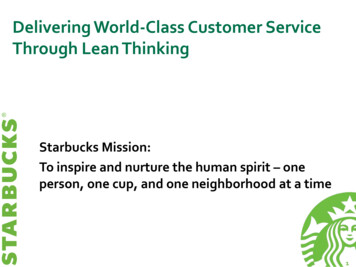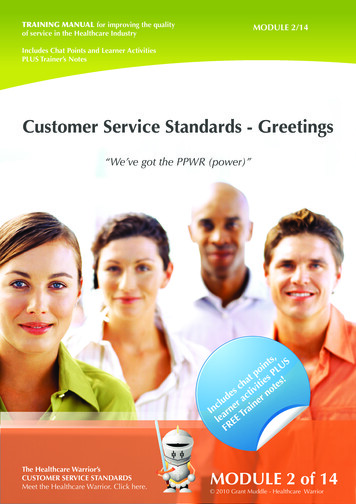
Transcription
TRAINING MANUAL for improving the qualityof service in the Healthcare IndustryMODULE 2/14MODULE 2 - Healthcare Warrior’s CUSTOMER SERVICE STANDARDS - Greeting Standards. 2010 Grant MuddleIncludes Chat Points and Learner ActivitiesPLUS Trainer’s NotesCustomer Service Standards - Greetings“We’ve got the PPWR (power)”The Healthcare Warrior’sCUSTOMER SERVICE STANDARDSMeet the Healthcare Warrior. Click here.MODULE 2 of 14 2010 Grant Muddle - Healthcare Warrior
MODULE 2 - Healthcare Warrior’s CUSTOMER SERVICE STANDARDS - Greeting Standards. 2010 Grant MuddleSummary of the Healthcare Warrior’sTraining Programme - 14 Modules.ModuleService Standards Description1The 4 Pillars of Service - You’ve got the PPWR2Greetings -The importance of a warm and professional greeting on arrival3Offering Service - Appropriate ways to offer service in a Healthcare setting4Requests - How to handle requests professionally5Unreasonable requests - How to compromise with positive outcomes for all6Dealing with complaints in a Healthcare setting - From the patient and fromthe patient’s family/loved ones7How to deal with angry and irritated patients8Serving children9Addressing the specific needs of women10Appropriate ways to touch patients11Professional dress standards12Telephone Etiquette - Answering the Telephone professionally - Why its such abig deal13Telephone Etiquette - Transferring calls - How to and when is it OK14Telephone Etiquette - Taking messages and the importance of relaying themcorrectly to patients
Module #2: GreetingsThe aim of this moduleMODULE 2 - Healthcare Warrior’s CUSTOMER SERVICE STANDARDS - Greeting Standards. 2010 Grant Muddle9999To understand the imprtance of greeting patients and guests in the correct mannerTo have a solid undersanding of the standards expected when you greet customerswithin your organisationWhy are greetings so important - The moment of truthThe moment a customer comes into contact with your organisation forthe first time, whether the customer walks into your office or receivesmail from, or talks to an employee over the phone, these first seconds ofinitial contact are called, The moment of truth.Greetings can be a moment of truth in many instances, as it is the firstimpression a customer may have of our company. And as you know, youdon’t get a second chance to make a first impression. So it needs to bedone correctly, every single time.Greetings are not just the words we use, but also the acknowledgementwe give patients and guests upon seeing them.Using PPWR to shape our greetings standards.Using the PPWR concept introduced in Module 1 of this training serieswe set a standard that adheres to the practice of being Professional,Personal, Warm & Responsive.We can greet our patients & guests in such a way that we can changetheir world in an instant, because “we’ve got the PPWR”.Don’t underestimate the power of a positive greeting.When greeting, use your PPWR skills!CHAT POINTWho has ever been upset, angry or just generally in a bad mood andthen you went somewhere, maybe to visit a friend, or you went into ashop and you were greeted in such a way that the person changed yourbad mood and made you feel better? You hold this power - use it!
MODULE 2 - Healthcare Warrior’s CUSTOMER SERVICE STANDARDS - Greeting Standards. 2010 Grant Muddle4 Greeting StandardsThere are four (4) main greeting standards that MUST BE met as aminimum.1.Within 3 seconds of arrival, acknowledge patient or guestwith a) eye contact & smile OR b) greeting & smile2.Greet patients using their name or preferred title and ifpossible, greet guests by name3.Offer service within a 3 minute period4.Initial statement to patient or customer to be a non-businessrelated statement or question
MODULE 2 - Healthcare Warrior’s CUSTOMER SERVICE STANDARDS - Greeting Standards. 2010 Grant MuddleGreeting Standards - 11.Within 3 seconds of arrival, acknowledge patient orguest witha) eye contact & smile :)ORb) greeting & smile :)These combinations will ensure that the patients and guests feel welcome and willunderstand that you know they are there in need of service.SmilingSometimes when we are busy it’s easy to forget to smile.When we are smiling, we need to ensure that our smile is genuine & not forced. Asimple warm, genuine smile can break down barriers and this will help our patientsfeel welcome.Eye ContactEye contact is also very important. Eye contact means looking people in the eye, butat the same time, not staring and trying to intimidate them.Initial GreetingsThe following are acceptable greetings:“Good Morning ”“Good Afternoon ”“Good Evening ”
MODULE 2 - Healthcare Warrior’s CUSTOMER SERVICE STANDARDS - Greeting Standards. 2010 Grant MuddleGreeting Standards - 1LEARNER ACTIVITYWhat type of greetings are NOT acceptable in a healthcare setting?CHAT POINTDoes our first greeting standard (1) reflect the four Pillars of Service PPWR? How could we make them fit better into this service philosophy?What else could we be doing when we make initial contact?
MODULE 2 - Healthcare Warrior’s CUSTOMER SERVICE STANDARDS - Greeting Standards. 2010 Grant MuddleGreeting Standards - 2/32. Greet patients using their name and if possible, greetguests by name.Greeting patients and guests by name gives personalized service and gives patients asense of belongingTips For Remembering Names . Use the persons name a couple more times in the course of the conversationWrite down their name after they leaveAssociate their name with someone or something that may help you rememberit3. Offer Service Within 3 Minutes - Is it possible?It is important that we set a benchmark so that the patients will always haveconfidence in knowing that they will be attended to within an acceptable period oftime.If you are already dealing with a patient or guest, your offer of service may be, “Hellothere, I will be with you as soon as I can”.If it is obvious you will be spending longer than 3 minutes with your current guest,ask the other guests to “please take a seat” because you “may be more than a fewminutes.”Be honest and let them know an estimated time frame if possible. Golden rule when it comes to service time, do not promise what you cannot deliver.CHAT POINTDo these greeting standards (2 & 3) fall in line with our PPWR servicephilosophy? How can we make them better?
MODULE 2 - Healthcare Warrior’s CUSTOMER SERVICE STANDARDS - Greeting Standards. 2010 Grant MuddleGreeting Standards - 44.Initial statement to patient or customer to be a non-businessrelated statement or questionMaking our initial greetings non-business related personalizes our communicationwith the patient.We are also building a rapport by learning more about them and who they are.At the same time, we are showing them warmth and helping to ensure they feelwanted and suitably cared for.LEARNER ACTIVITYWrite down some of your own examples of non-business relatedopening statements or questions. Explain why they are appropriate in ahealthcare service setting.Remember.First impressions last!
The Healthcare Warrior’s10 CommandmentsMODULE 2 - Healthcare Warrior’s CUSTOMER SERVICE STANDARDS - Greeting Standards. 2010 Grant Muddleof Superior Customer ServiceCustomers are:1.2.3.The most important people in any organizationNot dependant on us – we are dependant on themNot interruptions to our work – they are thepurpose of it4. Doing us a favour when they call – we are notdoing them a favour by serving them5. Part of our organization6. Not cold statistics – they are human beings withfeelings like our own7. Not someone to match wits with8. People who have wants – it’s our job to fill thosewants9. Deserving of the most courteous and attentivetreatment we can give them10. The lifeblood of this and every organizationPPWR. PPWR. PPWR.This Customer Service Training Module is 2 of 14 designed and authored by the Healthcare Warrior - GrantMuddle. (Serious Title. Serious Mission.) You can catch up with Grant and ask questions on his blog.http://healthcarewarrior.com
TRAINER’S NOTESTRAINING MANUAL for improving the qualityof service in the Healthcare IndustryMODULE 2/14Includes Chat Points and Learner ActivitiesPLUS Trainer’s NotesTRAINER’S NOTESMODULE 2 - Healthcare Warrior’s CUSTOMER SERVICE STANDARDS - Greeting Standards. 2010 Grant MuddleSession Time - 20 minutesCustomer Service Standards - Greetings“We’ve got the PPWR (power)”The Healthcare Warrior’sCUSTOMER SERVICE STANDARDSMeet the Healthcare Warrior. Click here.MODULE 2 of 14 2010 Grant Muddle - Healthcare Warrior
TRAINER’S NOTESMODULE 2 - Healthcare Warrior’s CUSTOMER SERVICE STANDARDS - Greeting Standards. 2010 Grant MuddleSummary of the Healthcare Warrior’sTraining Programme - 14 Modules.ModuleService Standards Description1The 4 Pillars of Service - You’ve got the PPWR2Greetings -The importance of a warm and professional greeting on arrival3Offering Service - Appropriate ways to offer service in a Healthcare setting4Requests - How to handle requests professionally5Unreasonable requests - How to compromise with positive outcomes for all6Dealing with complaints in a Healthcare setting - From the patient and fromthe patient’s family/loved ones7How to deal with angry and irritated patients8Serving children9Addressing the specific needs of women10Appropriate ways to touch patients11Professional dress standards12Telephone Etiquette - Answering the Telephone professionally - Why its such abig deal13Telephone Etiquette - Transferring calls - How to and when is it OK14Telephone Etiquette - Taking messages and the importance of relaying themcorrectly to patients*TRAINER’S NOTES.PARTS IN ORANGE DO NOT APPEARIN THE PARTICIPANT’S HANDOUTAND ARE THERE AS PROMPTS FOR THETRAINER.
TRAINER’S NOTESModule #2: GreetingsThe aim of this moduleMODULE 2 - Healthcare Warrior’s CUSTOMER SERVICE STANDARDS - Greeting Standards. 2010 Grant Muddle9999To understand the imprtance of greeting patients and guests in the correct mannerTo have a solid undersanding of the standards expected when you greet customerswithin your organisationWhy are greetings so important - The moment of truthThe moment a customer comes into contact with your organisation forthe first time, whether the customer walks into your office or receivesmail from, or talks to an employee over the phone, these first seconds ofinitial contact are called, The moment of truth.Greetings can be a moment of truth in many instances, as it is the firstimpression a customer may have of our company. And as you know, youdon’t get a second chance to make a first impression. So it needs to bedone correctly, every single time.Greetings are not just the words we use, but also the acknowledgementwe give patients and guests upon seeing them.Using PPWR to shape our greetings standards.Using the PPWR concept introduced in Module 1 of this training serieswe set a standard that adheres to the practice of being Professional,Personal, Warm & Responsive.We can greet our patients & guests in such a way that we can changetheir world in an instant, because “we’ve got the PPWR”.Don’t underestimate the power of a positive greeting.When greeting, use your PPWR skills!CHAT POINTWho has ever been upset, angry or just generally in a bad mood andthen you went somewhere, maybe to visit a friend, or you went into ashop and you were greeted in such a way that the person changed yourbad mood and made you feel better? You hold this power - use it!
TRAINER’S NOTESMODULE 2 - Healthcare Warrior’s CUSTOMER SERVICE STANDARDS - Greeting Standards. 2010 Grant Muddle4 Greeting StandardsThere are four (4) main greeting standards that MUST BE met as aminimum.1.Within 3 seconds of arrival, acknowledge patient or guestwith a) eye contact & smile OR b) greeting & smile2.Greet patients using their name or preferred title and ifpossible, greet guests by name3.Offer service within a 3 minute period4.Initial statement to patient or customer to be a non-businessrelated statement or question
TRAINER’S NOTESMODULE 2 - Healthcare Warrior’s CUSTOMER SERVICE STANDARDS - Greeting Standards. 2010 Grant MuddleGreeting Standards - 11.Within 3 seconds of arrival, acknowledge patient orguest witha) eye contact & smile :)ORb) greeting & smile :)These combinations will ensure that the patients and guests feel welcome and willunderstand that you know they are there in need of service.SmilingSometimes when we are busy it’s easy to forget to smile.When we are smiling, we need to ensure that our smile is genuine & not forced. Asimple warm, genuine smile can break down barriers and this will help our patientsfeel welcome.*Ask participants to sound happy when frowning and sound angry when smiling.Usually no-one can do it - it’s physically impossible. Body language is important.Eye ContactEye contact is also very important. Eye contact means looking people in the eye, butat the same time, not staring and trying to intimidate them.*ASK “Have you ever walked into a store or a party or any setting and the serviceperson or host has ignored you? Looked away without acknowledging you? How didit make you feel?Initial GreetingsThe following are acceptable greetings:“Good Morning ”“Good Afternoon ”“Good Evening ”
TRAINER’S NOTESMODULE 2 - Healthcare Warrior’s CUSTOMER SERVICE STANDARDS - Greeting Standards. 2010 Grant MuddleGreeting Standards - 1LEARNER ACTIVITYWhat type of greetings are NOT acceptable in a healthcare setting?Shouting outWaving from across the roomGreeting with silenceNot announcing yourself on entering a patient’s roomUsing humour - not everyone has the same sense of humour- you may unintentionally offend.CHAT POINTDoes our first greeting standard (1) reflect the four Pillars of Service PPWR? How could we make them fit better into this service philosophy?What else could we be doing when we make initial contact?
TRAINER’S NOTESMODULE 2 - Healthcare Warrior’s CUSTOMER SERVICE STANDARDS - Greeting Standards. 2010 Grant MuddleGreet
Making our initial greetings non-business related personalizes our communication with the patient. We are also building a rapport by learning more about them and who they are. At the same time, we are showing them warmth and helping to ensure they feel wanted and suitably cared for.
